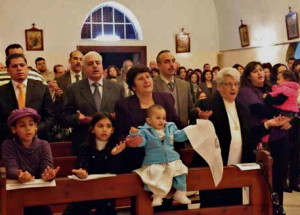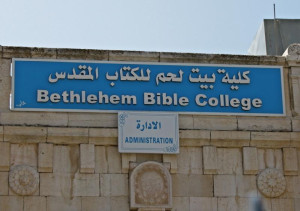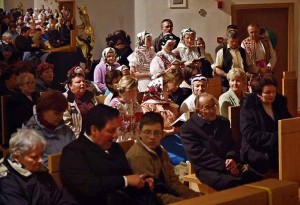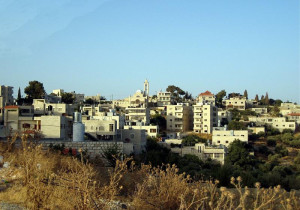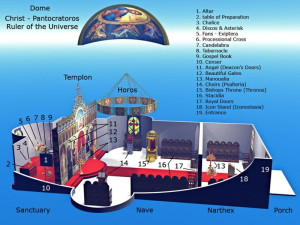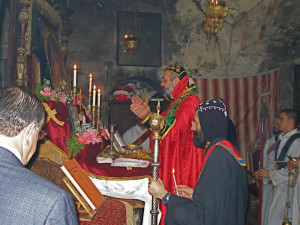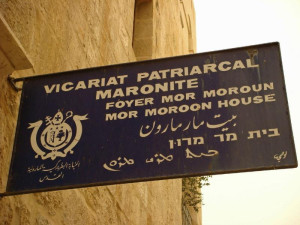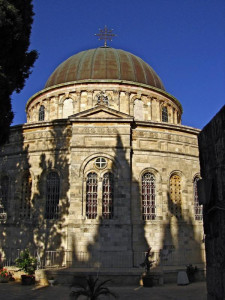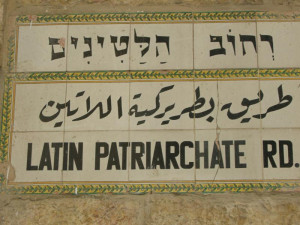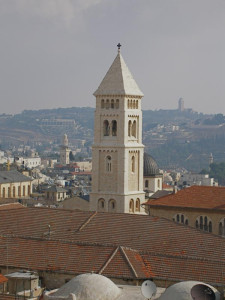If visitors to the Holy Land look past the quarried stones of holy sites and shrines they can encounter members of Christian communities who have worshipped at these holy places since Christianity began.
These “living stones”, as they are often called, make up the first indigenous Christian community in the world.
The first followers of Jesus were Jews or Jewish proselytes — a biblical expression that included gentiles who had converted to Judaism and gentiles who were considered “resident aliens” in the land of Israel or Palestine.
Although the Christian Church began as a movement within Judaism (and its first 15 bishops were of Jewish ethnicity), by the end of the first century it was becoming more gentile than Jewish.
Descendants of the early Christians still live in the villages and cities of Israel, Palestine and Jordan. Among their ancestors were those who heard Jesus preach, saw him heal the sick, and perhaps were among the 5000 miraculously fed on loaves and fishes. Bible history happened in their back yard.
These Christians are in Jerusalem, in Bethlehem, in Galilee and in Jordan. They tend olive trees, trade in the souks, teach in colleges, subsist in refugee camps.
Now divided into Orthodox, Catholic and Protestant communities, their predominant language is Arabic (Acts 2:5-11 notes that Arabs were among the polyglot crowd gathered in Jerusalem at Pentecost).
Visits are welcome
For pilgrims to join the often-vibrant Christian communities of the Holy Land in worship and discussion is a welcome act of solidarity and encouragement.
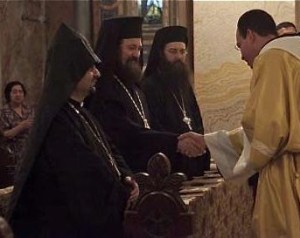
Franciscan friar welcomes Armenian, Greek and Romanian Orthodox representatives to an ecumenical service (© Custodia Terrae Sanctae)
To visit the holy places without acknowledging the Christians who have lived and worshipped there from the time of the first apostles is a disappointment to these beleaguered people.
Living in a predominantly Judaeo-Muslim world, the Christians of the Holy Land continually struggle for religious identity. Economic hardship, political uncertainty, and religious and ethnic discrimination are faced daily.
Yet Western Christians largely ignore these members of the “Mother Church” of Christianity, even though their numbers are declining to an alarming level — less than 2% of the population in Israel and Palestine.
The struggle to lead a normal life has caused thousands of Christians to emigrate, especially from Palestine.
More than half of all Christian Palestinians now live outside the Holy Land. The West Bank city of Bethlehem, once a Christian town, is now mostly Muslim. There are more Christians from Bethlehem living in Santiago, Chile, than in their home town where Christ was born.
Numbers are falling
In 2014, Israel had just over 8 million people, the Palestinian Territories 4.5 million and Jordan 6.5 million.
Christians were estimated to make up between 2 and 3 per cent of these totals (over 2 per cent in Israel and Jordan and about 1.25 per cent in Palestine). The proportions in Israel and the Palestinian Territories had declined from about 10 per cent before 1948.
In the state of Israel, the major groups were:
• 120,000 to 130,000 Arab Christians (mainly living in the north of the country and in mixed Jewish-Arab cities like Haifa and Ramla);
• 30,000 to 40,000 Christians who were integrated into the Hebrew-speaking population (mostly Russian-speaking immigrants from the former Soviet Union or Eastern Europe); and
• About 160,000 Christian migrant workers (primarily from Asia), asylum seekers (primarily from Africa) and overstayers (mainly from Eastern Europe).
In the Palestinian Territories (and East Jerusalem) there were about 50,000 Christians, almost all of them Palestinian Arabs.
One village in the West Bank, Taybeh, was entirely inhabited by Christians. An estimated 650,000 Christians of Palestinian origin lived overseas, mostly in the Americas and Western Europe.
In the other Holy Land countries:
In Jordan there were about 250,000 Christian citizens who were Jordanian and Palestinian Arabs. In addition there were tens of thousands of Christian migrant workers from Asia and Africa, and thousands of Christians among the refugees from Syria and Iraq.
The Jordanian villages of Semakìeh, Fuhèis and Shàtana were predominantly Christian.
Christians in Egypt numbered more than 12 million in early 2010, making up about 15% of the population. Coptic Orthodox predominated, but there were also big communities of Coptic Catholic and Protestants.
Christians in Syria numbered around 1.5 million, making up about 8% of the population. Orthodox (Greek, Syriac, Armenian) predominated, then Eastern Catholics and a smaller number of Latin Catholics and Protestants.
Worship is different
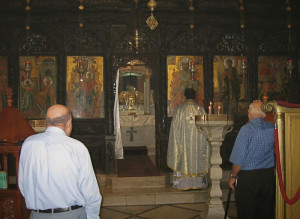
Greek Orthodox altar glimpsed through iconostasis in St Gabriel’s Church, Nazareth (© Ori~ / Wikimedia)
In the mosaic of Christian communities in the Holy Land, the Byzantine (or Greek) Orthodox and Byzantine Catholic churches make up the vast majority.
Thirteen traditional churches are recognised by the civil authorities in Israel: Greek Orthodox, Latin (or Roman) Catholic, Armenian Orthodox, Greek (or Melkite) Catholic, Maronite Catholic, Syriac Orthodox, Syriac Catholic, Coptic Orthodox, Ethiopian Orthodox, Armenian Catholic, Chaldean, Anglican and Lutheran.
There are also many Protestant and Evangelical churches.
The Christian churches of the Holy Land constitute a rich diversity of languages, liturgies, national identities and clerical dress. God is worshipped here — where Christian worship first developed — in ways that may disconcert Western pilgrims.
Interiors of church buildings are often covered with frescos and other paintings. The sanctuary around the altar is usually set apart by a screen decorated with icons (the iconostasis). Votive lamps hang in profusion.
Worship services tend to be more elaborate and prolonged than in the West, with bells, candles, incense and chanting. Singing is usually unaccompanied by musical instruments, since it is considered that only the human voice — made by God — can worthily praise him.
Worshippers express their personal piety by moving around to light candles, kiss icons and make their own prayers. People come and go freely during a service.
Opportunities to meet
How can Western pilgrims encounter local Christians in the Holy Land? There are many possibilities, and travel agents can often make the contacts.
The following suggestions come mainly from A Third Millennium Guide to Pilgrimage to the Holy Land, edited by Duncan Macpherson:
• Before leaving home, read about the situation of the Holy Land’s Christians.
• Request a Christian guide for your group (many Christian Palestinians depend on tourism for their livelihood).
• Worship with a Christian congregation and, if possible, stay and talk to its members afterwards.
• Ask for a meeting with a local church leader, or a speaker from a local church.
• Visit a church-sponsored educational, medical or social service institution, or a development project of a charity you support.
• Arrange to meet foreign Christians working with a church or other non-governmental organisation.
• Ask for a visit to a refugee camp, human rights centre, legal aid centre or peace organisation.
• Make your purchases in shops run by churches or which sell goods produced for development projects or co-operatives.
• Stay at Christian hospices or hostels where possible.
• Talk about the situation of Christians in the Holy Land when you return home.
Finally, your travel agent or an interfaith group can arrange meetings with representatives of the other two living religions of the Holy Land, Judaism and Islam, who are working for peace, justice and reconciliation.
Further article:
Churches in the Holy Land (and their origins)
Church contacts in Jerusalem
Greek Orthodox Patriarchate (and museum, open 9.30am-1pm daily), Greek Orthodox Patriarchate Road, tel. 00972-2-627-4941
Romanian Orthodox Patriarchate’s Representation, 46 Shivtei Israel Street, tel. 00972-2-626-4628 or 626-0847
Russian Ecclesiastical Mission in Jerusalem (Moscow Patriarchate), 6 Kheshin Street, Russian Compound, tel. 00972-2-625-2565
Russian Ecclesiastical Mission of the Russian Church Abroad, tel./fax 00972-2-628-6381
Armenian Orthodox Patriarchate, Armenian Orthodox Patriarchate Road, tel. 00972-2-628-2331
Coptic Orthodox Patriarchate, Via Dolorosa Ninth Station, tel. 00972-2-627-2645
Ethiopian Orthodox Patriarchate, Via Dolorosa Eighth Station, tel. 00972-2-628-2848 or 628-6871; Dabra Gannat Ethiopian Monastery, 10 Ethiopian Street, tel. +972-2-628-6871
Syriac Orthodox Patriarchate, St Mark’s Road, tel. 00972-2-628-3304 or 626-4758
Armenian Catholic Patriarchal Exarchate, 36 Via Dolorosa, Third Station, tel. 00972-2-628-4262
Chaldean Patriarchal Exarchate, 7 Chaldean Street (off Nablus Road), tel. 00972-2-628-4519
Franciscan Custody of the Holy Land, St Saviour’s Monastery, 1 St Francis Street, tel. 00972-2-626-6595 or 626-6777; St Saviour’s Church, tel. 00972-2-628-2868
Greek Catholic (Melkite) Patriarchal Vicariate (and museum, open 9am-1pm daily except Sunday), Greek Catholic Patriarchate Road, tel. 00972-2-628-2023 or 627-1968
Hebrew-speaking Catholic Vicariate, 10 Rabbi Kook Street, 00972-2-624-8255
Latin Patriarchate, Latin Patriarchate Road, tel. 00972-2-628-2323 or 627-2280
Maronite Patriarchal Exarchate, 25 Maronite Convent Road, tel. 00972-2-628-2158
Syriac Patriarchal Exarchate, 6 Chaldean Street (off Nablus Road), tel. 00972-2-628-2657 or 627-4318
ANGLICAN/PROTESTANT/EVANGELICAL
Christian and Missionary Alliance, 55 Haneviim Street, tel. 00972-2-625-4669 or 623-4804
Church of God (Pentecostal), Mount of Olives near Commodore Hotel, tel. 00972-2-627-3899
Episcopal Church of Jerusalem and the Middle East, St George’s Cathedral, 20 Nablus Road, tel. 00972-2-627-1670 or 627-2133; Christ Church, Jaffa Gate, 00972-2-627-7727 or 627-7729
Evangelical Lutheran Church of Jordan and the Holy Land (Church of the Redeemer), Muristan Road, tel. 00972-2-626-6800; English-speaking congregation, 00972-2-627-6111 or 628-1049
King of Kings Assembly, 24 Ben Maimon Street, tel. 00972-2-561-0017
St Andrew’s Scots Memorial Church (Presbyterian), Harakevet Street, tel. 00972-2-673-2401
Seventh-Day Adventist Church, 4 Abraham Lincoln Street, tel. 00972-2-625-1547
Southern Baptist Convention, 4 Narkis Street, tel. 00972-2-625-5942 or 623-1680
JEWISH CHRISTIANS
Hebrew Christians/Messianic Jews: contact Caspari Centre, 36 Jaffa Road, tel. 00972-2-623-3926
PHOTO CREDITS: Where the images above are not created by Seetheholyland.net, links to the sources can be found on our Attributions Page.References
Bausch, William J.: Pilgrim Church: A Popular History of Catholic Christianity (Twenty-Third Publications, 1993)
Caffulli, Giuseppe: “Jordan’s Christians: A Living Force” (Holy Land Review, Winter 2010)
Cragg, Kenneth: The Arab Christian: A History in the Middle East (Westminster/John Knox, 1991)
Doyle, Stephen: The Pilgrim’s New Guide to the Holy Land (Liturgical Press, 1990)
Eber, Shirley, and O’Sullivan, Kevin: Israel and the Occupied Territories: The Rough Guide (Harrap-Columbus, 1989)
Faris, John D.: “Peter’s First See” (CNEWA World, March-April 2003)
Hilliard, Alison, and Bailey, Betty Jane: Living Stones Pilgrimage: With the Christians of the Holy Land (Cassell, 1999)
McCormick, James R.: Jerusalem and the Holy Land: The first ecumenical pilgrim’s guide (Rhodes & Eaton, 1997)
Macpherson, Duncan (ed.): A Third Millennium Guide to Pilgrimage to the Holy Land (Melisende, 2000)
Marchadour, Alain, and Neuhaus, David: The Land, the Bible and History: Toward the Land That I Will Show You (Fordham University Press, 2007)
Pentin, Edward: “Leading Efforts to Keep Christians in Holy Land” (Holy Land Review, Spring 2009)
External links
Christian Information Centre, Jerusalem (contact information, times of church services, feast days, etc.)
Middle East Council of Churches (members include Eastern Orthodox, Oriental Orthodox, Catholic and Evangelical churches)
The Churches of the Holy Land (Pope Francis in the Holy Land 2014 official website)
Interreligious Coordinating Council in Israel (promotes reconciliation among Jews, Christians and Muslims)
Al-Liqa’ Center for Religious and Heritage Studies in the Holy Land (promotes dialogue between Christians and Muslims, and between them and Jews)
Jerusalem Center for Jewish-Christian Relations (promotes understanding and peace between Jews and Christians)
Sabeel Ecumenical Liberation Theology Center (grassroots movement among Palestinian Christians)
Al-Bushra (Arab-American resource on Middle East heritage and issues)
Holy Land Christian Ecumenical Foundation (United States organisation promoting solidarity with Holy Land Christians)
Living Stones (United Kingdom trust promoting contacts with Christian communities in the Holy Land)

